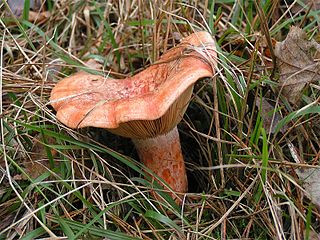
Lactarius deliciosus, commonly known as the delicious milk cap, saffron milk cap and red pine mushroom, is one of the best known members of the large milk-cap genus Lactarius in the order Russulales. It is native to Europe, but has been accidentally introduced to other countries along with pine trees, with which the fungus is symbiotic.
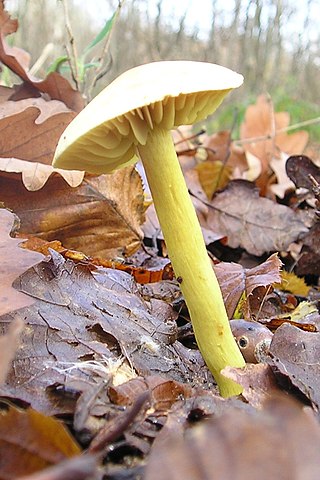
Tricholoma sulphureum, also known as the stinker, sulphur knight or gas agaric, is an inedible or mildly poisonous mushroom found in woodlands in Europe. It has a distinctive bright yellow colour and an unusual smell likened to coal gas. It occurs in deciduous woodlands in Europe from spring to autumn.

Tapinella atrotomentosa, commonly known as the velvet roll-rim or velvet-footed pax, is a species of fungus in the family Tapinellaceae. Although it has gills, it is a member of the pored mushroom order Boletales. August Batsch described the species in 1783. It has been recorded from Asia, Central America, Europe and North America. Tough and inedible, it grows on tree stumps of conifers. The mushroom contains several compounds that act as deterrents of feeding by insects.
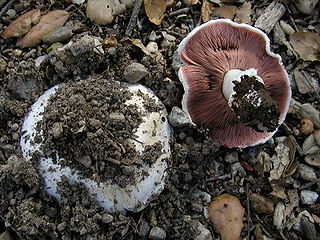
Agaricus bitorquis, commonly known as torq, banded agaric, spring agaric, banded agaricus, urban agaricus, or pavement mushroom, is an edible white mushroom of the genus Agaricus, similar to the common button mushroom that is sold commercially. The name supersedes Agaricus rodmani.

Clitocybe nebularis or Lepista nebularis, commonly known as the clouded agaric, cloudy clitocybe, or cloud funnel, is an abundant gilled fungus which appears both in conifer-dominated forests and broad-leaved woodland in Europe and North America. Appearing in Britain from mid to late autumn, it is edible, but may cause gastrointestinal issues.

Gymnopilus sapineus, commonly known as the scaly rustgill or common and boring gymnopilus, is a small and widely distributed mushroom which grows in dense clusters on dead conifer wood. It has a rusty orange spore print and a bitter taste. This species does not stain blue and lacks the hallucinogen psilocybin.
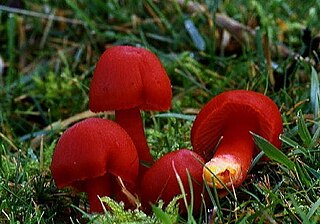
Hygrocybe coccinea, sometimes called the scarlet hood, scarlet waxcap or righteous red waxy cap, is a colourful member of the mushroom genusHygrocybe. These waxcaps are found across the Northern Hemisphere from China and Japan to Europe and North America. The small bright red mushroom is a familiar sight in unimproved grasslands in Europe in late summer and autumn, and woodlands in North America in winter.

Russula sanguinaria, commonly known as the bloody brittlegill or rosey russula, is a strikingly coloured mushroom of the genus Russula, which has the common name of brittlegills. It is bright blood-red, inedible, and grows in association with coniferous trees. It was previously widely known as Russula sanguinea.

Tricholoma ustaloides is a species of mushroom in the large genus Tricholoma. It has a widespread distribution in Europe, where it is typically found in association with oak and beech trees. Although generally considered inedible, it is consumed by some in Mexico.

Scutellinia scutellata, commonly known as the eyelash cup, the Molly eye-winker, the scarlet elf cap, the eyelash fungus or the eyelash pixie cup, is a small saprophytic fungus of the genus Scutellinia. It is the type species of Scutellinia, as well as being the most common and widespread. The fruiting bodies are small red cups with distinct long, dark hairs or "eyelashes". These eyelashes are the most distinctive feature and are easily visible with a magnifying glass. The species is common in North America and Europe, and has been recorded on every continent. S. scutellata is found on rotting wood and in other damp habitats, typically growing in small groups, sometimes forming clusters. It is sometimes described as inedible, but its small size means it is not suitable for culinary use. Despite this, it is popular among mushroom hunters due to its unusual "eyelash" hairs, making it memorable and easy to identify.

Ampulloclitocybe clavipes, commonly known as the club-foot or club-footed clitocybe, is a species of gilled mushroom from Europe and North America. The grey brown mushrooms have yellowish decurrent gills and a bulbous stalk, and are found in deciduous and conifer woodlands. Although considered edible, disulfiram-like reactions have been reported after consumption of alcohol after eating this mushroom.

Aspropaxillus giganteus, also Leucopaxillus giganteus, commonly known as the giant leucopax or the giant funnel, is a saprobic species of fungus in the order Agaricales. As its common names imply, the fruit body, or mushroom, can become quite large—the cap reaches diameters of up to 50 cm (20 in). It has a white or pale cream cap, and is funnel-shaped when mature, with the gills running down the length of the stem. Considered by some to be a choice edible when young, this species has a cosmopolitan distribution, and is typically found growing in groups or rings in grassy pastures, roadside hedges, or woodland clearings. It has been shown to contain a bioactive compound with antibiotic properties.

Leucopaxillus albissimus, commonly known as the large white leucopaxillus, is a species of mushroom that lives as a saprobe, decaying the litter under coniferous trees. It produces a large white fruiting body that is unusually resistant to decay. It is considered to be inedible.

Russula albidula is a species of mushroom in the genus Russula. The species, known in the vernacular as the boring white russula or the whitish brittlegill, is nondescript, with a small or medium dirty white fruit body, and a highly acrid taste. It is found in eastern North America.

Tricholoma saponaceum, also known as the soap-scented toadstool, soapy tricholoma, soapy knight or soap tricholoma is an inedible mushroom found in woodlands in Europe and North America.

Suillus tomentosus is a species of mushroom. The common names of the species are blue-staining slippery Jack, poor man's slippery Jack, and woolly-capped suillus.
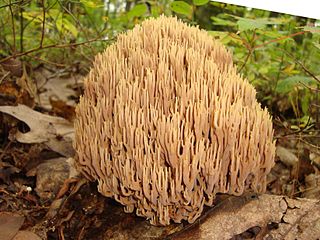
Ramaria stricta, commonly known as the strict-branch coral is a coral fungus of the genus Ramaria. It has a cosmopolitan distribution, and grows on dead wood, stumps, trunks, and branches of both deciduous and coniferous trees. Its fruit body is up to 10 cm tall, made of multiple slender, compact, and vertical parallel branches. Its color is typically light tan to vinaceous-brown. All parts of the mushroom will bruise when handled. There are several lookalike corals that can usually be distinguished from R. stricta by differences in coloration, bruising reaction, or microscopic features. The fungus is inedible due to its unpleasant odor and bitter taste.

Gomphidius subroseus, commonly known as the rosy gomphidius is a gilled mushroom found in Europe and North America. It was first described by Calvin Henry Kauffman in 1925. It was once thought to be mycorrhizal with Pinus sylvestris. However, Olson et al. (2002) found it to be more likely to be parasitic on Suillus bovinus, which is mycorrhizal with Pinus sylvestris, Pinus sylvestris or both. It is considered edible but of low quality. As with other species of the genus, removing the glutinous cuticle improves the taste.

Hygrophorus chrysodon, commonly known as the flaky waxy cap, is a species of fungus in the genus Hygrophorus. It is edible but bland in taste. The species is found throughout the Northern Hemisphere.
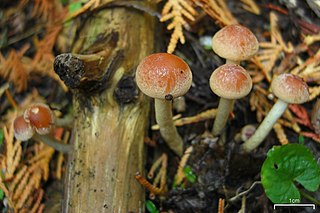
Pholiota astragalina, commonly known as the pinkish-orange pholiota, is a species of fungus in the family Strophariaceae. It was first described scientifically in 1821 by Elias Magnus Fries as a species of Agaricus. Rolf Singer transferred it to the genus Pholiota in 1951. The fruitbodies of the fungus have pinkish-orange caps measuring 2–5.5 cm in diameter. The flesh is orange, blackening in age, with a bitter taste. They produce a reddish-brown spore print, causing it to be placed in its genus rather than Hypholoma, which it resembles. The spores are oval to elliptical, smooth with thin walls, and measure 5–7 by 4–4.5 µm. In North America, the fungus is found in the United States and Canada. In Europe, it has been recorded from France, Sweden, and Switzerland. Its mushrooms usually grow singly or in small clusters, sometimes on conifer logs.




















